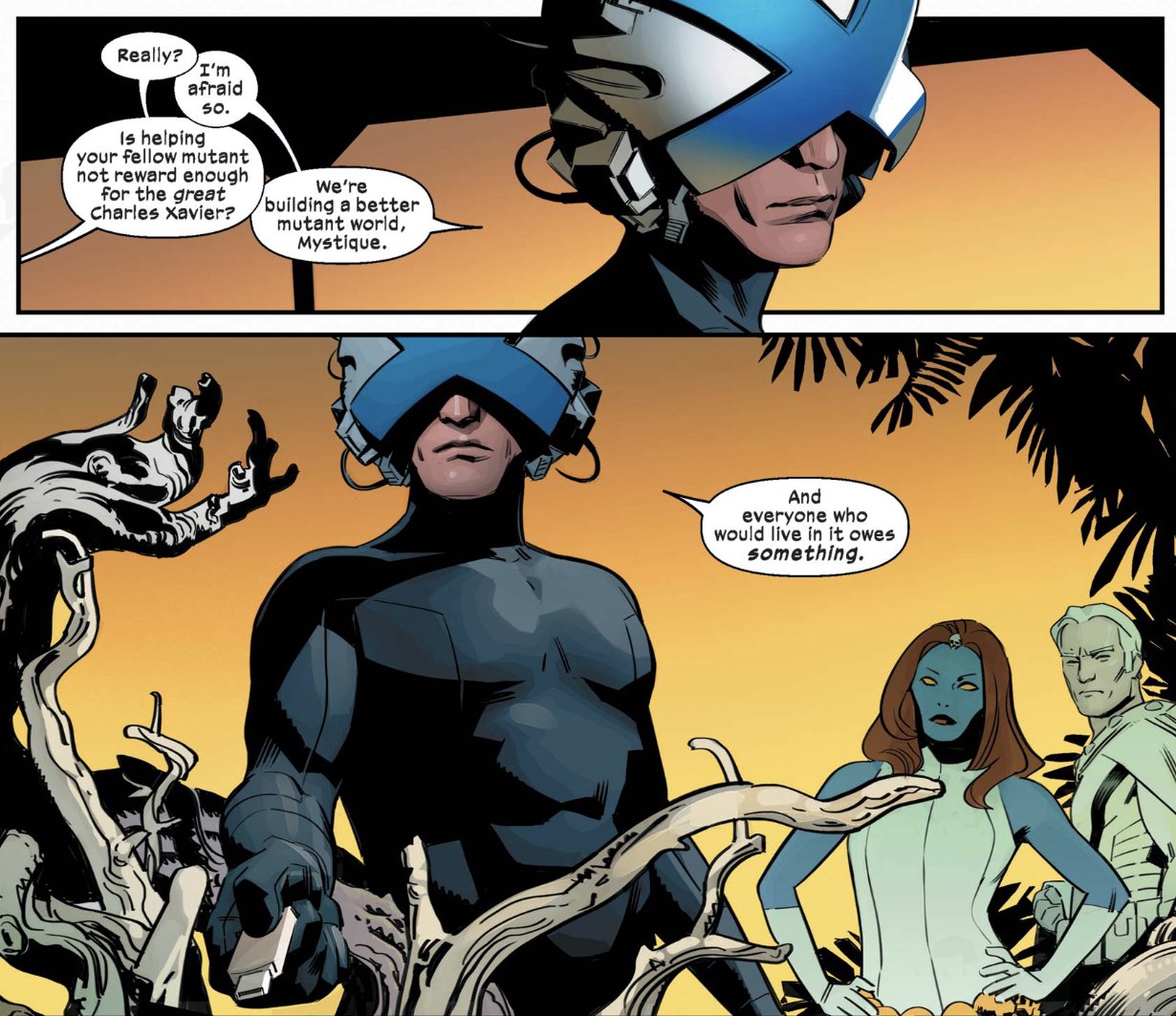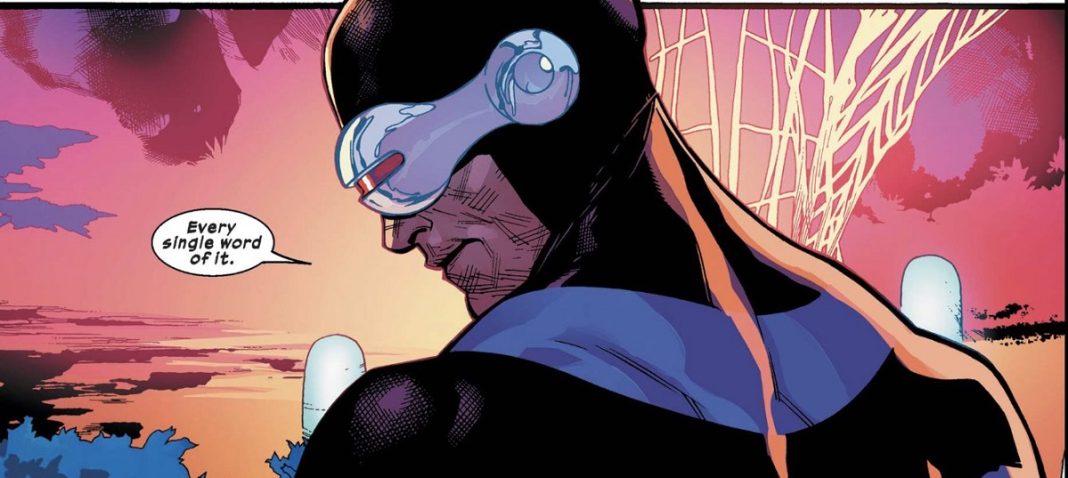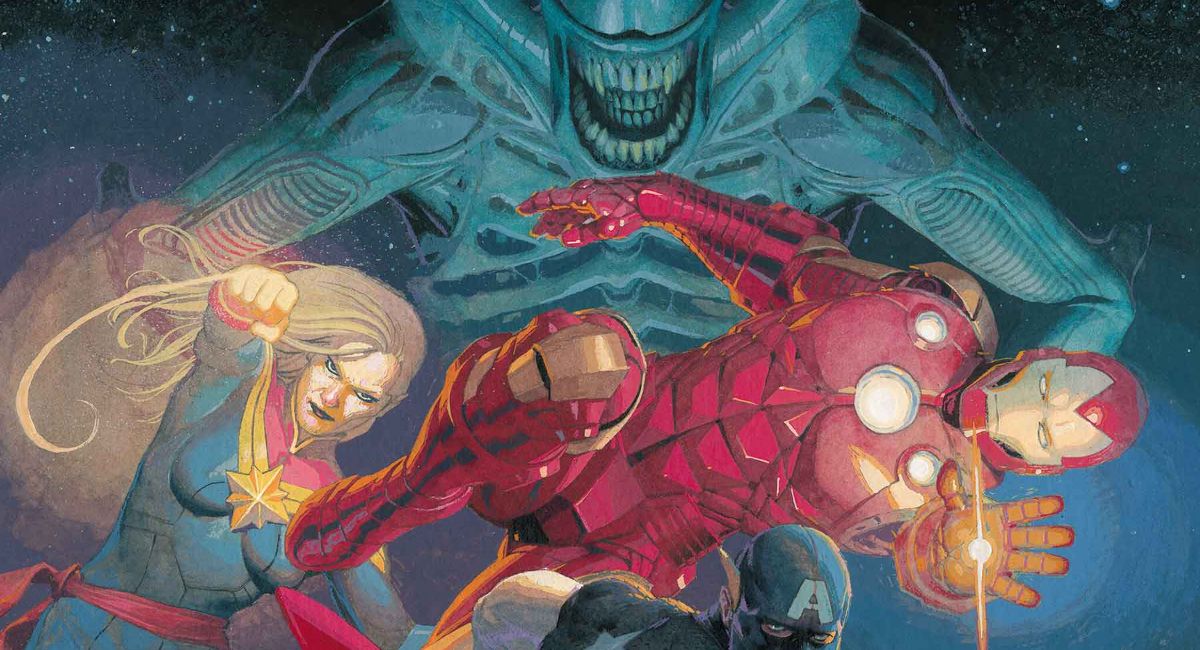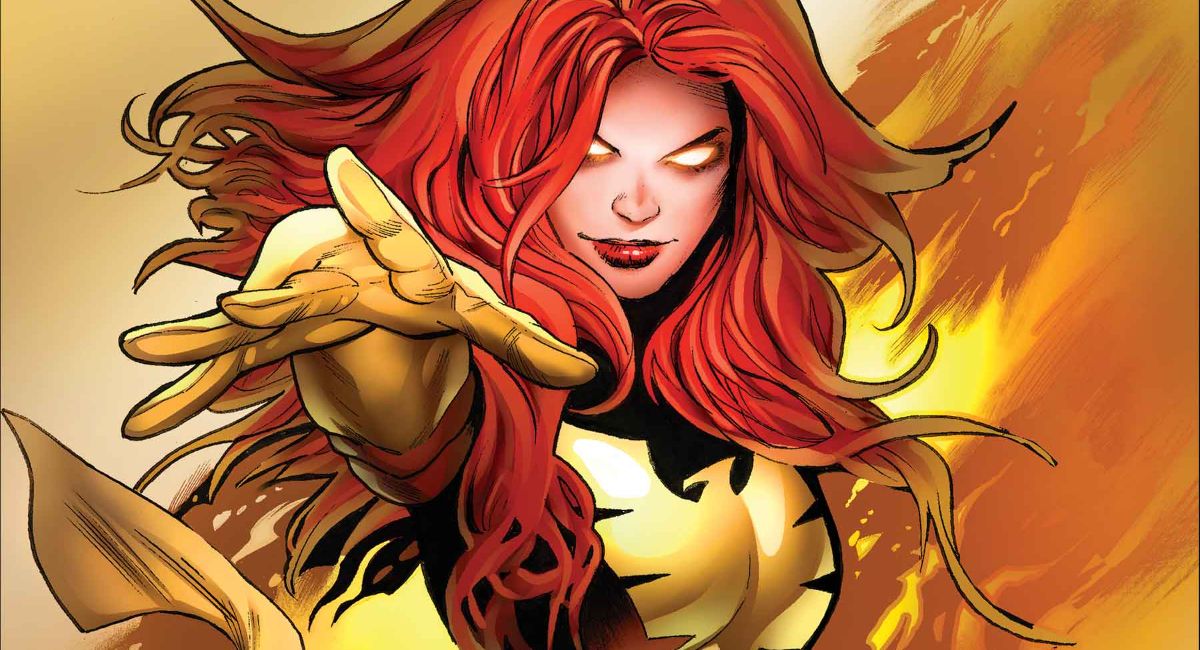Welcome to Heroes of X, the sister series to History Of X, two monthly columns where an unapologetically queer X-Men fan dissects, celebrates and analyzes the past, present, and future of Marvel’s merry mutant narrative. Have you been reading along already? Wonderful, we love to see it. If you’re just now joining the party, check out the landing page for previous entries in the “two series that are one” here.
After the conclusion of the House of X and Powers of X dual miniseries/blended maxi-series, the X-Men corner of the Marvel Universe enters its next phase with the Dawn Of X. This era of X-books further fleshes out the new mutant status quo introduced in HOX/POX and traces the early threats and exploits of the newly established sovereign mutant nation of Krakoa. The modern X-Men line is beautifully organized in trade paperbacks and oversized hardcovers, so there’s never been a better time to hop on and start reading.
Hickman’s 21-issue run on the X-Men title (collected in Hickman Omnibus Hardcover and the X of Swords Omnibus) is non-linear and focuses on somewhat disconnected world-building vignettes set during the first few months after House of X. Following the timeline can be difficult but definitely not impossible. You can also DWAI the whole thing (‘Don’t Worry About It’ a common refrain on the exemplary X-Men podcast Cerebro) and just enjoy the ride.
That said, if you’re neurotic and crave organization like myself, I recommend searching for a timeline or chronological reading order that makes sense to you. For the purpose of this column, I used “The Krakoa Era” timeline linked here, and we’ll be looking at X-Men issues that take place over roughly one month of time in-universe.
I Believed in a Thing… and Now It’s Real.
In X-Men #1 from Jonathan Hickman, Leinil Francis Yu & Sunny Gho, the reader is caught up on the current state of mutant affairs. Most of the issue follows Scott Summers AKA Cyclops, one of the core X-Men leaders, and an Omega Level “sufferer” whose resting state is angst-ridden. I love this issue for many reasons, not the least of which is that Cyclops, the X-Men’s erstwhile mopey boy, seems to be really feeling himself. We see Scott smiling and playing house with his whole extended family. Scott is rarely shown vibing and happy in his 60 years of publication history, so seeing him feeling confident and optimistic is a welcome change of pace. Krakoa looks good on him. But perhaps we’re getting ahead of ourselves.

The issue opens with panels of darkness pinpricked by red, the reader is viewing the world from Scott’s perspective with his eyes closed. Charles Xavier asks Scott and by extension the reader to “Open your eyes.” The request is both literal and metaphorical, suggesting that humankind refuses and/or is incapable of seeing the truth. In this brief scene from the past, early in Professor Xavier and Scott Summer’s relationship, we are reminded of how their bond began. Xavier provides Scott with support and understanding as both a mutant and a person living with a disability.
Scott’s vision and his concussive optic blasts are both a tool and a disability. While his optic blasts are his primary offensive strength in a combat scenario, Scott is incapable of opening his eyes without releasing the destructive beams of force. Ruby quartz lenses act as both an assistive device and a dam, allowing Scott to traverse the world more smoothly while holding back the overwhelming power of his mutation. To read further on the successes and failures of disability representation in the X-Men please check out this blog post by author Annalee at The Bias.

Following this scene, we’re thrust into the X-Men’s assault on the last earth-based Orchis stronghold. Orchis is established in HOXPOX as a human super science “doomsday protocol” made up of members of various organizations with acronyms whose purpose is observing mutant activity, tracking mutant financial influence, and destabilizing mutant population growth. It’s very easy to draw a straight line between Orchis and real-life far-right organizations that peddle racist garbage like “replacement theory.” Basically, they’re bigots with a budget and they suck.
Cyclops, Storm, Magneto, and Polaris succeed in taking the stronghold, fighting off the Ph.D. Apes (DWAI), freeing the mutants trapped inside (while inadvertently releasing Serafina a “post-human” member of the Children of the Vault a group you can read more about here), and return to Krakoa through a gateway. They are received with a hero’s welcome and Magneto in particular is celebrated by mutant children eager to hear of his battle. This scene further establishes Krakoa as a haven for mutant kind. We see mutant children thriving, protected, and free to grow with less fear of human violence. The dream is as real as it’s ever been.
This issue also includes one of the most talked about infographics in the early run of the Krakoa era: the blueprint and layout of Summer House (see below). Let me put on my realtor blazer and skirt set real quick. Eh hem. The extended Summers family lives in a spacious 9-bedroom blue-area-of-the-moon adjacent Krakoan Biome with high ceilings, jet hangers, an underground pool, and a full gym. But the luxurious amenities of Summer House weren’t what got readers talking, instead, it was the adjoining bedrooms of Cyclops, Jean Grey, and Wolverine. With one graphic, Hickman and company all but blatantly state that the historic love triangle of the X-Men has transitioned into a “throuple.” (If you’re feeling curious, you can read this essay I wrote about being in a throuple and later officiating the wedding of my two exes after our relationship transitioned to a new phase, it’s the first piece of writing I ever published!) We’re truly living in a blessed era of X-Men comics.

I Want My Wife Back: The Raven Darkholme Story
X-Men #6 seems to mostly take place immediately following the action of X-Men #1. We see a flashback to a pre-Krakoa moment with mutant shapeshifter Mystique and the precognitive Destiny discussing a mysterious vision of the future. In another scene, still in the past but more recent, Professor Xavier and Magneto send a reluctant Mystique on a mission to plant a Krakoan gate on the Orchis station. Mystique succeeds before being launched out of an airlock to die in space. After resurrection, Mystique is tasked with another mission to confirm the success of the previous mission. This cycle is clearly taxing and unfair. Mystique completes all of the tasks they are burdened with before hitting a wall and finally demanding that Xavier make good on his promise to resurrect Destiny, confirming for the first time on-panel that Destiny is their wife.

For many long-time queer readers, this moment was extremely validating and simultaneously heartbreaking. Mystique and Destiny’s romantic relationship had long been eluded to in comics but never explicitly stated on the page due to both the comics code and homophobic editorial mandates by the likes of former Marvel EIC Jim “Don’t Say Gay” Shooter.
Despite Mystique’s sordid history of horrible deeds, murders, and manipulations I found myself empathizing with their plight. Queer people have been denied their rights and access to their partners in so many real-world scenarios, so watching this queer character desperately plead to be afforded the same rights as their peers was a painful experience. In past stories queer readers had to look between the panels to see our issues represented, by making Mystique and Destiny textually queer characters, the mutant metaphor is unburdened from needing to cover so much. They are both mutant and queer, and those intersections of identity are so important.
Xavier, Magneto, and — from the shadows — Moira X are perhaps at their most cruel dangling the promised resurrection of Mystique’s lover over their head like a golden-masked carrot. This cruelty will eventually bite them in the ass, as it should. The issue closes with the completion of its opening scene. Destiny in all her precog-the-house-down-boots glory has anticipated the Krakoan leadership’s less-than-egalitarian approach to mutant resurrection and thus entreated Mystique to “burn that place to the ground.”

I Know Pain
X-Men #2 picks up after a violent assassination on Krakoan soil in the pages of X-Force. A mysterious island (The Arak Coral is your nasty) full of eldritch Lovecraftian beasts has appeared near Krakoa and suddenly the island-that-moves-like-a-boat is rushing towards it. Sounds like a job for Cyclops and his timeline-addled children Gen Z Cable AKA Nathan Christopher Charles Askani’Son Summers and Rachel “I refuse to call her Prestige” Summers!
This issue introduces the eerie Arraki mutant known only as Summoner! Summoner is serving 300-year-old nightmare twink meets Ash Ketchum by way of Halloweentown and I love that for them! They’re ooky, they’re spooky, and they announce the names of their terrifying Pokemon before launching an attack. I choose you Hool-go-Dir The Vanquished God! Eldritch-mon! It’s all great fun.

To be honest y’all, a lot of these new introductions are very confusing upon first reading. Hickman is not one for holding the reader’s hand through the big ideas, and he is a writer who deals in MASSIVE concepts. If it doesn’t all make sense to you immediately, don’t feel bad, I’m personally still connecting all the dots and I just reread all of it.
A lot of what Hickman and company introduce in these early issues won’t really be fully explained until around X of Swords and even then it is a lot of information that begs for rereading and further research. That’s what blogs are for!
Long story long, Summoner is a mutant from Arakko, the sister/lover/other-half of Krakoa. You can tell they’re close because their names are anagrams. The islands used to be one entity called Okkara before a cataclysmic event split them in two and a sacrifice trapped Arakko and its people in the daemonic dimension of Amenth. The Arak Maw is a volcano/portal located on a chunk of Arakkothat was sent back to Earth with Summoner in tow to seek aid from the ancient mutant Apocalypse! Did that all make sense? Of course, it did. (Legit I’ve been staring at Marvel Database pages for days trying to sum this stuff up.)
By the end of the issue, Rachel manages to settle the communication issues between the Krakoan mutants and the Arakki Summoner. Krakoa merges with the Arak Coral and Summoner shares a tender nighttime hug with big daddy Apocalypse who assures the ghostly figure that he means to save all of his children, “those of Krakoa and those of Arakko.”

X-Men #3 opens with an emergency meeting of Krakoa’s governing body, the Quiet Council. Cyclops and team are being sent out to address an issue with the Savage Land gate. Jean Grey and Emma Frost have settled into a sassy repartee (I can’t help but read Jean saying “I love those shoes” in a Hannibal Lecter voice) and we learn that Krakoa HAS BEEN FEEDING ON ALL THE MUTANTS PSYCHIC ENERGY! Don’t worry, it’s not that big of a deal because Krakoa only nibbles a little bit of energy from all the mutants all of the time but when something is wrong IT NEEDS TO FEED MORE!
At this point, a little over a month has passed since the mutants announced Krakoa publicly, and besides all of the things that are going wrong, things have been pretty cool. Enter Hordeculture, a cadre of “radical botanists’ ‘ AKA mean old science grannies with guns who love Mother Earth and hate what people have done to her. Krakoa has interrupted their plans to take control of the world’s food supply and they’re mad as hell and they’re not gonna take it anymore. This crew is honestly one of my favorite Hickman-Yu inventions. Often in superhero comics, the only “elderly” characters who get to kick ass are… well… hmmm. Well, there’s the Vulture, he’s old… and Magneto is old sometimes… Oh, and Aunt May was a herald of Galactus that one time. Basically, if you’re not functionally immortal, you don’t usually get to be an old badass.

I couldn’t help but sort of root (eh eh?) for the women of Hordeculture while they brutalized Sebastian Shaw because honestly, it’s never a bad time to beat up the Black King of the Hellfire club. Hordeculture and their mission statement introduce an interesting ripple in the geopolitical landscape of the Krakoa era. While Augusta, Opal, Lily, and Edith are clearly violent eco-terrorists, they’re also not “wrong.” Human consumption and expansion are destroying the earth, like all the best villains, Hordeculture makes some valid points.

Rub Elbows With My Betters
X-Men #4 is an astoundingly plotted “bottle episode” taking place almost entirely in one room during the World Economic Forum. While Cyclops and Gorgon deal with a secret strike team poised to make another assassination attempt on Krakoan leadership, Magneto, Professor Xavier, and Apocalypse trade words with various world leaders. The real action in this book is entirely verbal. Every time I read this issue, which is often, I get goosebumps.
The conversations that take place while obviously fantastical and fictitious carry over into our world with startling clarity. We live in an era where politicians ban any teaching of history that mentions systemic oppression, living expenses have skyrocketed while wages stall, military and policing budgets swell, and the people are told there is no money to provide housing for the homeless. As Magneto explains to the international group of leaders what mutants have learned from watching human governments manipulate, extort, and control populations, I feel my chest tighten because it’s all so real. Krakoa and its leaders are more than willing to get their hands dirty to protect their people and for some readers that is a difficult pill to swallow.

In this issue I find myself both celebrating the mutants’ political prowess, and nervous about what Krakoa could become. Krakoa is sort of an ethnostate which is troubling but at the same time, it was formed without displacing other people. Krakoa’s governing body was not elected which is troubling, to say the least, but the land itself has a place on that ruling council making their government something that has never been seen before. Krakoa’s status as both landmass and sentient participant makes it unique from any other nation-state that has ever existed.
The geopolitical implications of this issue are so large and stretch far beyond my expertise but luckily there is a lot of work already focused on this specific issue out there. Check out this conversation between New York Times Opinion columnist Jamelle Bouie, Spencer Ackerman, Daily Beast National Security Reporter, and host Elana Levin on the Graphic Policy podcast.

Hickman’s X-Men is expansive and almost overwhelming with all of its new ideas. I’m so excited to have this opportunity to reread these story arcs with a critical lens. This is an era that truly benefits from being read multiple times as each issue takes on new significance with more context. Having recently read the first two issues of Victor Lavelle’s Sabertooth, which takes place roughly concurrently with the issues discussed above, I find the ethics of Krakoan society further complicated. The X-Men have never been a simple project, and nor should they be, but this era is certainly the mutants at their most complex. While some readers may bristle at their favorite characters shifting into a new paradigm, “I believe in adaptation. You might even say it’s my religion.”
Read previous entries in the History of X/Heroes of X series!
Buy the X-Men by Jonathan Hickman Omnibus!
Micheal Foulk is a non-binary queer writer, comedian, and organizer thriving in Oakland, California. They are the co-host of I’m Not Busy — a weekly podcast with Vanessa Gonzalez — the co-creator of the LGBTQ+ storytelling show Greetings, from Queer Mountain and the curator of the film screening series Queer Film Theory 101, produced in collaboration with Alamo Drafthouse Cinemas. Their work has been published in Slate, Vice, Into, and TimeOut NY.
Micheal will make you a playlist if you ask nicely.







